Carrier 38AUQ User Manual
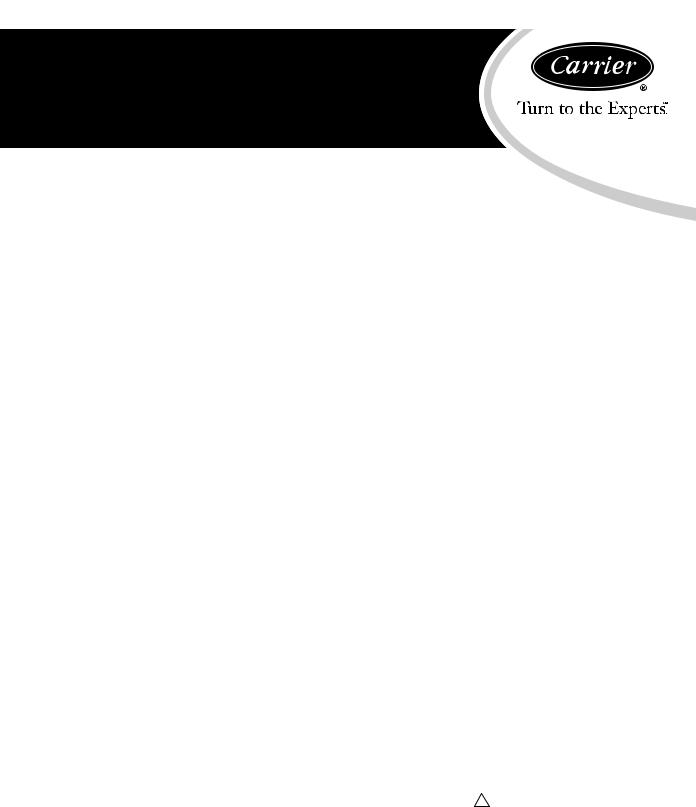
38AUQ
Heat Pump Condensing Units 60 Hz
with Puron® (R-410A) Refrigerant Sizes 07, 08, and 12
Installation, Start-Up and
Service Instructions
CONTENTS
SAFETY CONSIDERATIONS . . . . . . . . . . . . . . . . . . . . . . . 1 INSTALLATION GUIDELINES. . . . . . . . . . . . . . . . . . . . . . . 2 INSTALLATION . . . . . . . . . . . . . . . . . . . . . . . . . . . . . . . . 7-14 Step 1 – Plan for Unit Location . . . . . . . . . . . . . . . . . . . 7 Step 2 – Complete Pre-Installation Checks. . . . . . . . . . 7 Step 3 – Prepare Unit Mounting Support . . . . . . . . . . 7 Step 4 – Rig and Mount the Unit . . . . . . . . . . . . . . . . . . 7 Step 5 – Complete Refrigerant Piping Connections . . . 7 Step 6 – Install Accessories. . . . . . . . . . . . . . . . . . . . . . 10 Step 7 – Complete Electrical Connections . . . . . . . . . 10 PRE-START-UP . . . . . . . . . . . . . . . . . . . . . . . . . . . . . . . . 15 System Check . . . . . . . . . . . . . . . . . . . . . . . . . . . . . . . . . 15 Turn On Crankcase Heater . . . . . . . . . . . . . . . . . . . . . . 15 Preliminary Charge. . . . . . . . . . . . . . . . . . . . . . . . . . . . . 15 START-UP. . . . . . . . . . . . . . . . . . . . . . . . . . . . . . . . . . . . . 15 -18 38AUQ Units . . . . . . . . . . . . . . . . . . . . . . . . . . . . . . . . . 15 OPERATING SEQUENCE. . . . . . . . . . . . . . . . . . . . . . . . . . 19 Indoor (Supply) Fan . . . . . . . . . . . . . . . . . . . . . . . . . . . . 19 Cooling Unit Without Economizer. . . . . . . . . . . . . . . . . 19 Cooling, Unit With Economizer . . . . . . . . . . . . . . . . . . . 19 Heating. . . . . . . . . . . . . . . . . . . . . . . . . . . . . . . . . . . . 19 Supplemental Heating/Emergency Heating . . . . . . . . 19 Defrost Cycle . . . . . . . . . . . . . . . . . . . . . . . . . . . . . . . . . 19 Cooling and Heating Shutdown. . . . . . . . . . . . . . . . . 19 ROUTINE SYSTEM MAINTENANCE. . . . . . . . . . . . . . . 20 Quarterly Inspection (and 30 days after initial start). . 20 SERVICE. . . . . . . . . . . . . . . . . . . . . . . . . . . . . . . . . . . . . .20 - 31 Refrigeration System . . . . . . . . . . . . . . . . . . . . . . . . . 20 Compressor Oil. . . . . . . . . . . . . . . . . . . . . . . . . . . . . . . . 20
Servicing Systems on Roofs with
Synthetic Materials. . . . . . . . . . . . . . . . . . . . . . . . . . . . . 20 Liquid Line Filter Drier . . . . . . . . . . . . . . . . . . . . . . . . . 21 Filed Refrigerant Access Ports . . . . . . . . . . . . . . . . . 21 Outdoor Coil Metering Devices. . . . . . . . . . . . . . . . . 21 Refrigerant System Pressure Access Ports . . . . . . . . 21 Heat Pump Controls. . . . . . . . . . . . . . . . . . . . . . . . . . 22 Commercial Defrost Board . . . . . . . . . . . . . . . . . . . . . . 22 Crankcase Heater . . . . . . . . . . . . . . . . . . . . . . . . . . . . 22 Compressor Protection. . . . . . . . . . . . . . . . . . . . . . . . . . 22 Low-Pressure Switches . . . . . . . . . . . . . . . . . . . . . . . . . 33
Comfort Alert Diagnostic Module . . . . . . . . . . . . . . 28 Lubrication . . . . . . . . . . . . . . . . . . . . . . . . . . . . . . . . . . . 30
Outdoor Coil Maintenance and Cleaning Recommendations . . . . . . . . . . . . . . . . . . . . . . . . . . . 30
Service Parts . . . . . . . . . . . . . . . . . . . . . . . . . . . . . . . 31 Fastener Torque Values . . . . . . . . . . . . . . . . . . . . . . . 31 TROUBLESHOOTING . . . . . . . . . . . . . . . . . . . . . . . . . . . . 32
APPENDIX A
Air Conditioner and Heat Pump with Puron® –
Quick Reference Guide . . . . . . . . . . . . . . . . . . . . . . . 33 APPENDIX B
Wiring Diagram List. . . . . . . . . . . . . . . . . . . . . . . . . 33 APPENDIX C
Motormaster Sensor Locations. . . . . . . . . . . . . . . . . 34 START-UP CHECKLIST . . . . . . . . . . . . . . . . . . . .CL-1, CL-2
SAFETY CONSIDERATIONS
Improper installation, adjustment, alteration, service, maintenance, or use can cause explosion, fire, electrical shock or other conditions which may cause personal injury or property damage. Consult a qualified installer, service agency, or your distributor or branch for information or assistance. The qualified installer or agency must use factory-authorized kits or accessories when modifying this product. Refer to the individual instructions package
Follow all safety codes. Wear safety glasses and work gloves. Use quenching cloths for brazing operations and have a fire extinguisher available. Read these instructions thoroughly and follow all warnings or cautions attached to the unit. Consult local building codes and appropriate national electrical codes (in USA, ANSI/NFPA70, National Electrical Code (NEC); in Canada, CSA C22.1) for special requirements.
It is important to recognize safety information. This is the safety-alert symbol  . When you see this symbol on the unit and in instructions or manuals, be alert to the potential for personal injury.
. When you see this symbol on the unit and in instructions or manuals, be alert to the potential for personal injury.
Understand the signal words DANGER, WARNING, CAUTION, and NOTE. These words are used with the safetyalert symbol. DANGER identifies the most serious hazards which will result in severe personal injury or death. WARNING signifies hazards which could result in personal injury or death. CAUTION is used to identify unsafe practices, which may result in minor personal injury or product and property damage. NOTE is used to highlight suggestions which will result in enhanced installation, reliability, or operation.
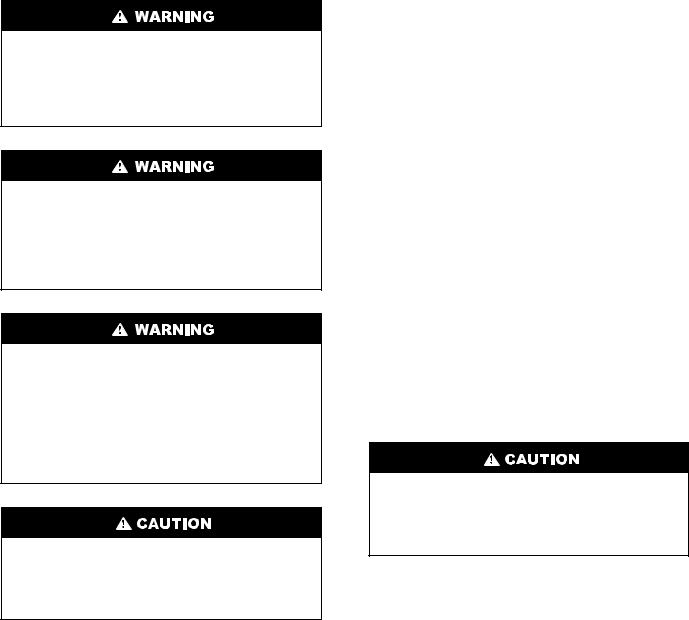
ELECTRICAL SHOCK HAZARD
Failure to follow this warning could cause personal injury or death.
Before performing service or maintenance operations on unit, always turn off main power switch to unit and install lockout tag. Unit may have more than one power switch.
UNIT OPERATION AND SAFETY HAZARD
Failure to follow this warning could cause personal injury, death and/or equipment damage.
Puron® (R-410A) refrigerant systems operate at higher pressures than standard R-22 systems. Do not use R-22 service equipment or components on Puron refrigerant equipment.
PERSONAL INJURY AND ENVIRONMENTAL HAZARD
Failure to follow this warning could cause personal injury or death.
Relieve pressure and recover all refrigerant before system repair or final unit disposal.
Wear safety glasses and gloves when handling refrigerants. Keep torches and other ignition sources away from refrigerants and oils.
CUT HAZARD
Failure to follow this caution may result in personal injury.
Sheet metal parts may have sharp edges or burrs. Use care and wear appropriate protective clothing, safety glasses and gloves when handling parts and servicing 38AUQ units.
INSTALLATION GUIDELINE
Replacement /Retrofit – R22 to Puron®
Split system heat pumps are intended to be installed with matching indoor sections only. The 38AUQ heat pump outdoor units are matched only with same-size 40RUQ indoor sections. Existing R-22 indoor coils cannot be converted to R-410A heat pump duty. Only the existing refrigerant piping is a candidate for retrofit use.
Acid test – If the existing system is being replaced because of a compressor electrical failure, assume acid is in system. If system is being replaced for any other reason, use an approved acid test kit to determine acid level. If even low levels of acid are detected, install a 100 percent activated alumina suction line filter drier in addition to the replacement liquid-line filter drier. Operate this system in COOLING ONLY. Remove the suction line filter drier as soon as possible, with a maximum of 72 hr of operation.
Recommendation: Install a ball valve in the liquid line at the filter drier location when installing a suction filter in the suction line.
Installation –
1.Remove the existing evaporator coil or fan coil and install the replacement coil.
2.Drain oil from low points and traps in suction line tubing if they were not replaced.
3.Remove the existing outdoor unit. Install the new outdoor unit according to these installation instructions.
4.Install the factory-supplied liquid-line filter drier at the indoor coil just upstream of the TXV.
UNIT DAMAGE HAZARD
Failure to follow this caution may result in equipment damage or improper operation.
Never install suction-line filter drier in the liquid-line of a Puron® system.
5.If required, install a 100% activated alumina suction line filter drier at the outdoor unit.
6.Evacuate and charge the system according to the instructions in this installation manual.
7.Operate the system for 10 hr. Monitor the pressure drop across the suction line filter drier. If pressure drop exceeds 3 psig (21kPa), replace suction-line and liquid-line filter driers. Be sure to purge system with dry nitrogen and evacuate when replacing filter driers. Continue to monitor the pressure drop across suction-line filter drier. Repeat filter changes is necessary. Never leave suctionline filter drier in system longer than 72 hr (actual time).
2
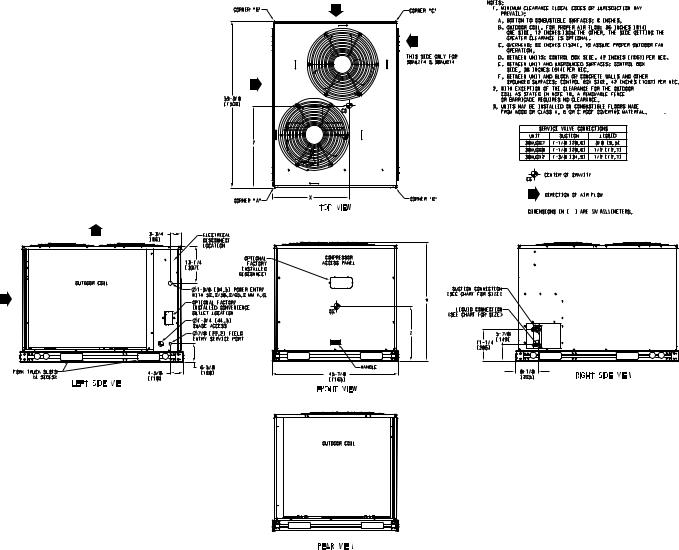
|
Standard |
Corner |
Corner |
Corner |
Corner |
|
Center of Gravity |
|
Unit Height |
|||||||||||
UNIT |
Weight |
|
A |
|
B |
|
C |
|
D |
|
|
|||||||||
|
|
|
|
|
|
|
|
|
|
|||||||||||
|
lbs. |
kg. |
lbs. |
|
kg. |
lbs. |
|
kg. |
lbs. |
|
kg. |
lbs. |
|
kg. |
X |
|
Y |
|
Z |
H |
38AUQ*07 |
444 |
201 |
134 |
|
61 |
97 |
|
44 |
90 |
|
41 |
123 |
|
56 |
23 |
|
26 |
|
13 |
42-3/8 |
|
|
|
|
[584] |
|
[660] |
|
[330] |
[1076] |
|||||||||||
|
|
|
|
|
|
|
|
|
|
|
|
|
|
|
|
|
||||
38AUQ*08 |
483 |
219 |
162 |
|
74 |
110 |
|
50 |
85 |
|
39 |
125 |
|
57 |
20 |
|
24 |
|
13 |
42-3/8 |
|
|
|
|
[508] |
|
[610] |
|
[330] |
[1076] |
|||||||||||
|
|
|
|
|
|
|
|
|
|
|
|
|
|
|
|
|
||||
38AUQ*12 |
575 |
261 |
186 |
|
84 |
126 |
|
57 |
106 |
|
48 |
157 |
|
71 |
21 |
|
24 |
|
23 |
50-3/8 |
|
|
|
|
[533] |
|
[610] |
|
[584] |
[1280] |
|||||||||||
|
|
|
|
|
|
|
|
|
|
|
|
|
|
|
|
|
||||
Fig. 1 — 38AUQ*07-12 Unit Dimensions
3
Table 1A — Physical Data — 38AUQ*07-12 Units — 60 Hz English
UNIT SIZE 38AUQ |
*07 |
|
*08 |
|
*12 |
|
NOMINAL CAPACITY (tons) |
6 |
|
7.5 |
|
10 |
|
OPERATING WEIGHTS (lb) |
|
|
|
|
|
|
|
Aluminum-Fin Coils |
444 |
|
483 |
|
575 |
|
|
|
|
|
|
|
REFRIGERANT TYPE‡ |
|
|
R-410A |
|
|
|
|
Operating Charge, Typical (lb)† |
18.0 |
|
21.0 |
|
27.0 |
|
Shipping Charge (lb) |
10.0 |
|
12.0 |
|
15.0 |
|
|
|
|
|
|
|
COMPRESSOR |
|
|
|
|
|
|
|
Qty...Type |
1...Scroll |
|
1...Scroll |
|
1...Scroll |
|
|
|
|
|
|
|
OUTDOOR FANS |
|
|
|
|
|
|
|
Qty...Rpm |
2...1100 |
|
2...1100 |
|
2...1100 |
|
Motor Hp |
1/4 |
|
1/4 |
|
1/4 |
|
Diameter (in) |
22 |
|
22 |
|
22 |
|
Nominal Airflow (Cfm Total) |
6,000 |
|
6,000 |
|
6,000 |
|
Watts (Total) |
610 |
|
610 |
|
610 |
|
|
|
|
|
|
|
OUTDOOR COIL (Qty) |
1...Round |
|
Tube/Plate Fin (RTPF) |
|||
|
Face Area (sq ft total) |
17.5 |
|
23.0 |
|
28.1 |
|
Rows/Fins per inch (FPI) |
2/17 |
|
2/17 |
|
2/17 |
|
|
|
|
|
|
|
CONTROLS |
|
|
|
|
|
|
|
Pressurestat Settings (psig) |
|
|
|
|
|
|
High Cutout |
630 ±10 |
|
630 ±10 |
|
630 ±10 |
|
|
|
||||
|
Cut-in |
505 ±20 |
|
505 ±20 |
|
505 ±20 |
|
Low Cutout |
27 ±3 |
|
27 ±3 |
|
27 ±3 |
|
Cut-in |
44 ±5 |
|
44 ±5 |
|
44 ±5 |
|
|
|
|
|
|
|
PIPING CONNECTIONS (in. ODS) |
1...11/8 |
|
1...11/8 |
|
1...13/8 |
|
|
Qty...Vapor |
|
|
|||
|
Qty...Liquid |
1...3/8 |
|
1...1/2 |
|
1...1/2 |
LEGEND |
|
|
|
|
|
|
ODS — Outside Diameter Sweat (socket) |
|
|
|
|
|
|
‡ |
Unit is factory-supplied with partial charge only. |
|
|
|
|
|
† |
Typical operating charge with 25 ft of interconnecting piping. |
|
|
|||
4
Table 1B — Physical Data — 38AUQ*07-12 Units — 60 Hz SI
UNIT SIZE 38AUQ |
*07 |
|
*08 |
|
*12 |
NOMINAL CAPACITY (kW) |
21.1 |
|
26.4 |
|
35.1 |
OPERATING WEIGHT (kg) |
|
|
|
|
|
Aluminum-Fin Coils |
201 |
|
219 |
|
261 |
|
|
|
|
|
|
REFRIGERANT TYPE‡ |
|
|
R-410A |
|
|
Operating Charge, Typical (kg)† |
8.2 |
|
9.5 |
|
12.2 |
Shipping Charge (kg) |
4.5 |
|
5.9 |
|
6.8 |
|
|
|
|
|
|
COMPRESSOR |
|
|
|
|
|
Qty...Type |
1...Scroll |
|
1...Scroll |
|
1...Scroll |
|
|
|
|
|
|
CONDENSER FANS |
|
|
|
|
|
Qty...r/s |
2...18 |
|
2...18 |
|
2...18 |
Motor Hp NEMA |
1/4 |
|
1/4 |
|
1/4 |
Diameter (mm) |
560 |
|
560 |
|
560 |
Nominal Airflow (L/s) |
2832 |
|
2832 |
|
2832 |
Watts (Total) |
610 |
|
610 |
|
610 |
|
|
|
|
|
|
CONDENSER COIL (Qty) |
1...Round |
|
Tube/Plate Fin (RTPF) |
||
Face Area (sq m total) |
1.6 |
|
2.1 |
|
2.6 |
Rows/Fins per Meter (Fins/m) |
2/670 |
|
2/670 |
|
2/670 |
|
|
|
|
|
|
CONTROLS |
|
|
|
|
|
Pressurestat Settings (kPa) |
|
|
|
|
|
High Cutout |
4344 ±70 |
|
4344 ±70 |
|
4344 ±70 |
|
|
||||
Cut-in |
3482 ±138 |
|
3482 ±138 |
|
3482 ±138 |
Low Cutout |
186 ±21 |
|
186 ±21 |
|
186 ±21 |
Cut-in |
303 ±35 |
|
303 ±35 |
|
303 ±35 |
|
|
|
|
|
|
PIPING CONNECTIONS (in. ODS) |
1...11/8 |
|
1...11/8 |
|
1...13/8 |
Qty...Vapor |
|
|
|||
Qty...Liquid |
1...3/8 |
|
1...1/2 |
|
1...1/2 |
LEGEND
NEMA — National Electrical Manufacturers Association
ODS — Outside Diameter Sweat (socket)
‡ Unit is factory-supplied with partial charge only.
† Typical operating charge with 7.62 m of interconnecting piping.
5
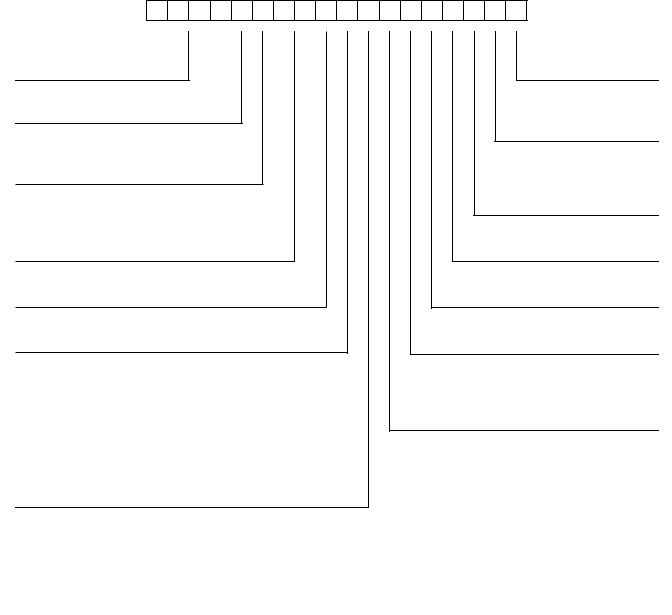
1 2 3 4 5 6 7 8 9 10 11 12 13 14 15 16 17 18
3 8 A U Q A 1 2 A 0 C 6 – 0 A 0 A 0
_____________ ____
Model Type
38AU= Carrier Condensing Unit Puronr R---410A Refrigerant
Type of Coil
Q = Heat Pump Scroll Compressor
Refrigerant Options
A = None
B = Low Ambient
Nominal Tonnage
07 = 6 Tons
08 = 7.5 Tons
12 = 10 Tons
Not Used
A = Not Used
Not Used
0 = Not Used
Coil Options
A= Al/Cu
B = Precoat Al/Cu
C = E-Coat Al/Cu
E= Cu/Cu
M= Al/Cu with Hail Guard
N = Precoat Al/Cu with Hail Guard
P = E-Coat Al/Cu with Hail Guard
R = Cu/Cu with Hail Guard
Packaging
0 = Standard
1 = LTL
Electrical Options
A = None
C = Non-Fused Disconnect
Service Options
0 = None
1 = Un-powered Convenience Outlet
2 = Powered Convenience Outlet
Not Used
A = Place Holder
Base Unit Controls
0 = Electro-Mechanical Controls
Design Revision
A= Initial Rev (Discrete Model Number)
Voltage
1 = 575/3/60
5 = 208/230/3/60
6 = 460/3/60
Fig. 2 — Model Number Nomenclature
POSITION NUMBER |
|
1 |
|
2 |
3 |
4 |
|
5 |
|
6 |
|
7 |
|
8 |
9 |
10 |
TYPICAL |
|
4 |
|
8 |
0 |
9 |
|
G |
|
1 |
|
2 |
|
3 |
4 |
5 |
|
POSITION |
|
|
|
|
|
DESIGNATES |
|
|
|
|
|
||||
|
|
1−2 |
|
|
|
Week of manufacture (fiscal calendar) |
|
|
|
|||||||
|
|
3−4 |
|
|
|
Year of manufacture (Ó09Ó = 2009) |
|
|
|
|||||||
|
5 |
|
|
|
Manufacturing location (G = ETP, Texas, USA) |
|
|
|||||||||
|
|
6−10 |
|
|
|
|
Sequential number |
|
|
|
|
|
||||
Fig. 3 — Serial Number Nomenclature
6
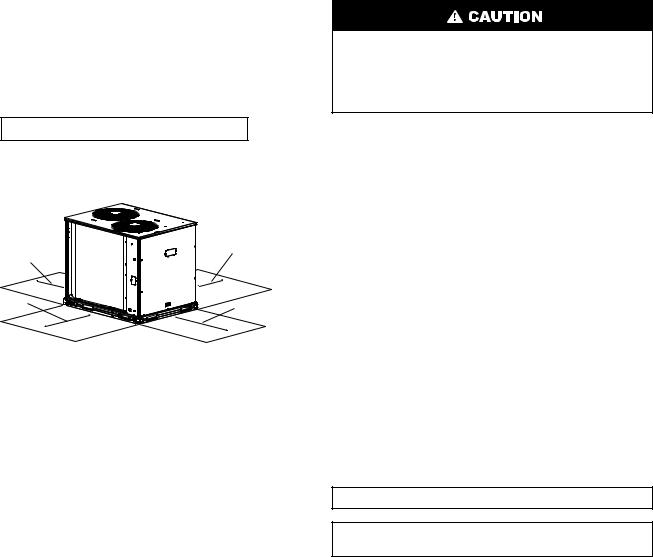
.INSTALLATION
Jobsite Survey
Complete the following checks before installation.
1.Consult local building codes and the NEC (National Electrical Code) ANSI/NFPA 70 for special installation requirements.
2.Determine unit location (from project plans) or select unit location.
3.Check for possible overhead obstructions which may interfere with unit lifting or rigging.
Step 1 — Plan for Unit Location
Select a location for the unit and its support system (pad, rails or other) that provides for the minimum clearances required for safety. This includes the clearance to combustible surfaces, unit performance and service access below, around and above unit as specified in unit drawings. See Fig. 4.
Select a unit mounting system that provides adequate height to allow for removal and disposal of frost and ice that will form during the heating-defrost mode.
NOTE: Consider also the effect of adjacent units on airflow performance and control box safety clearance.
Do not install the outdoor unit in an area where fresh air supply to the outdoor coil may be restricted or when recirculation from the condenser fan discharge is possible. Do not locate the unit in a well or next to high walls.
Evaluate the path and required line length for interconnecting refrigeration piping, including suction riser requirements (outdoor unit above indoor unit), liquid line lift (outdoor unit below indoor unit) and hot gas bypass line. Relocate sections to minimize the length of interconnecting tubing.
DO NOT BURY REFRIGERATION LINES.
Although unit is weatherproof, avoid locations that permit water from higher level runoff and overhangs to fall onto the unit.
|
RIGHT: |
|
REAR: |
Min 18” (457 mm) |
|
requried for service |
||
Min 18” (457 mm) |
||
requried for service |
|
|
LEFT: |
|
|
Min 18” (457 mm) |
FRONT: |
|
requried for service |
||
42” (1067 mm) |
||
|
||
Note: Observe requirements for 39” (914 mm) operating clearance |
||
on either Left or Rear coil opening.
Fig. 4 — Service Clearance Dimensional Drawing
Step 2 — Complete Pre-Installation Checks
CHECK UNIT ELECTRICAL CHARACTERISTIC — Confirm before installation of unit that voltage, amperage and circuit protection requirements listed on unit data plate agree with power supply provided.
UNCRATE UNIT — Remove unit packaging except for the top skid assembly, which should be left in place until after the unit is rigged into its final location.
INSPECT SHIPMENT — File a claim with shipping company if the shipment is damaged or incomplete.
CONSIDER SYSTEM REQUIREMENTS
•Consult local building codes and National Electrical Code (NEC, U.S.A.) for special installation requirements.
•Allow sufficient space for airflow clearance, wiring, refrigerant piping, and servicing unit. See Fig.1 for unit dimensions and weight distribution data.
•Locate the unit so that the outdoor coil (condenser) airflow is unrestricted on all sides and above.
•The unit may be mounted on a level pad directly on the base channels or mounted on raised pads at support points. See Tables 1A and 1B for unit operating weights. See Fig. 1 for weight distribution based on recommended support points.
NOTE: If vibration isolators are required for a particular installation, use the data in Fig. 1 to make the proper selection.
Step 3 — Prepare Unit Mounting Support
Slab Mount
Provide a level concrete slab that extends a minimum of 6 in. (150 mm) beyond unit cabinet. Install a gravel apron in front of condenser coil air inlet to prevent grass and foliage from obstructing airflow.
Step 4 — Rig and Mount the Unit
UNIT DAMAGE HAZARD
Failure to follow this caution may result in equipment damage.
All panels must be in place when rigging. Unit is not designed for handling by fork truck.
.
RIGGING — These units are designed for overhead rigging. Refer to the rigging label for preferred rigging method. Spreader bars are not required if top crating is left on the unit. All panels must be in place when rigging. As further protection for coil faces, plywood sheets may be placed against the sides of the unit, behind cables. Run cables to a central suspension point so that the angle from the horizontal is not less than 45 degrees. Raise and set the unit down carefully.
If it is necessary to roll the unit into position, mount the unit on longitudinal rails, using a minimum of 3 rollers. Apply force to the rails, not the unit. If the unit is to be skidded into position, place it on a large pad and drag it by the pad. Do not apply any force to the unit.
Raise from above to lift the unit from the rails or pad when unit is in its final position.
After the unit is in position, remove all shipping materials and top crating.
Step 5 — Complete Refrigerant Piping Connections
Refrigerant lines must be carefully designed and constructed to ensure equipment reliability and efficiency. Line length, pressure drop, compressor oil return, and vertical separation are several of the design criteria that must be evaluated. See Table 2.
IMPORTANT: Do not bury refrigerant piping underground.
IMPORTANT: A refrigerant receiver is not provided with the unit. Do not install a receiver.
7

Table 2 — 38AUQ*07-12 Piping Recommendations (Single-Circuit Unit)
R-410A |
|
|
|
Equivalent Length |
|
|
|
||
|
Ft |
0-38 |
|
38-75 |
|
75-113 |
|
113-150 |
|
|
|
|
|
|
|
|
|
|
|
Model |
Length Linear |
0-25 |
|
25-50 |
|
50-75 |
|
75-100 |
|
Nominal Capacity |
Length Equiiv |
0-38 |
|
38-75 |
|
75-113 |
|
113-115 |
|
38AUQ*07 |
Liquid Line |
3/8 |
|
3/8 |
|
3/8 |
1/2 |
3/8 |
1/2 |
|
Max Lift |
25 |
|
50 |
|
48 |
75 |
39 |
100 |
|
Cool |
|
|
||||||
|
Heat |
25 |
|
50 |
|
46 |
60 |
31 |
60 |
|
Suction Line |
7/8 |
|
7/8 |
|
1-1/8 |
|
1-1/8 |
|
|
Charge (lbs) |
17.8 |
|
18.8 |
|
20.3 |
22.6 |
21.4 |
24.5 |
|
|
|
|
|
|
|
|
|
|
38AUQ*08 |
Liquid Line |
1/2 |
|
1/2 |
|
1/2 |
|
1/2 |
|
|
Max Lift |
25 |
|
50 |
|
75 |
|
100 |
|
|
Cool |
|
|
|
|
||||
|
Heat |
25 |
|
50 |
|
60 |
|
60 |
|
|
Suction Line |
7/8 |
1-1/8 |
1-1/8 |
|
1-1/8 |
|
1-1/8 |
|
|
Charge (lbs) |
20.9 |
|
23.0 |
|
24.9 |
|
26.8 |
|
|
|
|
|
|
|
|
|
|
|
38AUQ*12 |
Liquid Line |
1/2 |
|
1/2 |
|
1/2 |
|
1/2 |
5/8 |
|
Max Lift |
25 |
|
50 |
|
75 |
|
85 |
100 |
|
Cool |
|
|
|
|||||
|
Heat |
25 |
|
50 |
|
60 |
|
60 |
60 |
|
Suction Line |
7/8 |
1-1/8 |
1-1/8 |
|
1-1/8 |
|
1-1/8 |
1-3/8 |
|
Charge (lbs) |
26.8 |
|
28.8 |
|
30.7 |
|
33.4 |
37.2 |
Legend: |
|
|
|
|
|
|
|
|
|
Length Equiv |
Equivalent tubing length, including effects of refrigeration specialties devices |
|
|
||||||
Liquid Line |
Tubing size, inches OD. |
|
|
|
|
|
|
|
|
Max Lift |
Maximum liquid lift at maximum permitted liquid line pressure drop |
|
|
|
|||||
Cooling |
• Indoor unit ABOVE outdoor unit |
|
|
|
|
|
|
||
Heating |
• Indoor unit BELOW outdoor unit |
|
|
|
|
|
|
||
Suction Line |
Tube size, inches OD |
|
|
|
|
|
|
|
|
Charge |
Charge Quantity, lbs. Calculated for both liquid line sizes (where applicable), but only with larger |
|
|||||||
|
suction line size (where applicable) |
|
|
|
|
|
|
||
|
|
||||||||
NOTE: |
For applications with linear length greater than 100 ft (30.5 m), contact your local Carrier representative. |
||||||||
CHECK VERTICAL SEPARATION — If there is any vertical separation between the indoor and outdoor units, check to ensure that the separation is within allowable limits. Relocate equipment if necessary.
PROVIDE SAFETY RELIEF — If local codes dictate an additional safety relief device, purchase locally and install locally. Installation will require the recovery of the factory shipping charge before the factory tubing can be cut and the supplemental relief device is installed.
REFRIGERANT LINE SIZING — Consider the length of the piping required between the outdoor and indoor units. The maximum allowable line length is 100 ft (30.5 m). See Table 2. Refrigerant vapor piping should be insulated.
IMPORTANT: A refrigerant receiver is not provided with the unit. Do not install a receiver.
INSTALL FILTER DRIER(S) AND MOISTURE INDICATOR(S) — Every unit MUST have a bi-directional filter drier in the liquid line. Locate the filter drier at the indoor unit, close to the evaporator coil’s thermal expansion valve (TXV) inlets.
38AUQ units include one Puron-duty filter drier, shipped in cartons attached to the unit basepan. Remove the filter drier and prepare to install in the liquid line at the evaporator coil. Do not remove connection fitting plugs until ready to connect and braze the filter drier into the liquid line position.
Table 4 — Puron-duty Filter Drier(s)
Model-Size |
Qty |
Liquid |
Desiccant |
Part |
|
Line OD |
Volume |
Number Ref |
|||
|
|
||||
38AUQ*07 |
1 |
3/8-in |
8 cu. in. |
KH43LG091 |
|
38AUQ*08 |
1 |
1/2-in |
16 cu. in. |
KH43LG085 |
|
38AUQ*12 |
1 |
1/2-in |
16 cu. in. |
KH43LG085 |
Table 3 — Maximum Vertical Separation*
UNIT 38AUQ |
UNIT 40RUQ |
DISTANCE FT (M) |
Unit 38AUQ |
||
|
|
Above Unit 40RMQ |
07 |
07 |
50 (15.2) |
08 |
08 |
60 (18.3) |
12 |
12 |
60 (18.3) |
*Vertical distance between indoor and outdoor units.
Installation of liquid line moisture indicating sightglass in each circuit is recommended. Locate the sightglass(es) between the outlet of the filter drier and the TXV inlet.
Refer to Table 5 for recommendations on refrigeration specialties.
Select the filter drier for maximum unit capacity and minimum pressure drop. Complete the refrigerant piping from the indoor unit to the outdoor unit before opening the liquid and suction lines at the outdoor unit.
8
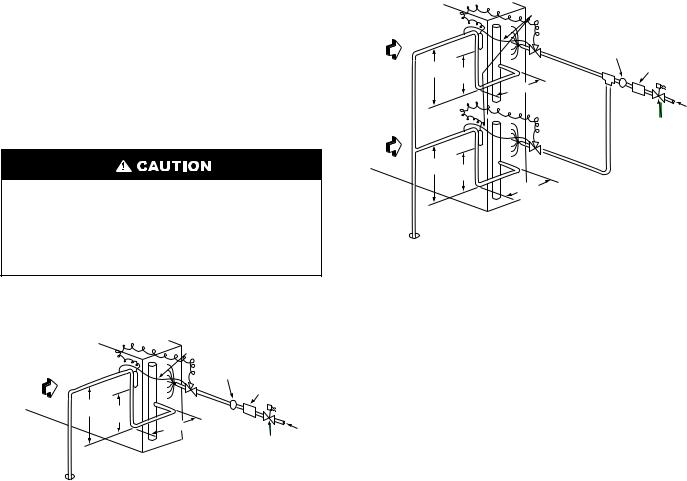
Table 5 — Refrigerant Specialties Part Numbers.
LIQUID LINE |
LIQUID LINE |
LLSV |
SIGHT |
FILTER |
||
SIZE (in.) |
SOLENOID VALVE (LLSV) |
COIL |
GLASS |
DRIER |
||
3/8 |
ALC-066208 |
AMG-24/50-60 |
HMI-1TT3 |
Provided with unit |
||
1/ |
2 |
ALC-066209† |
AMG-24/50-60 |
HMI-1TT4 |
||
See Table 4 |
||||||
5/8 |
ALC-066212 |
AMG-24/50-60 |
HMI-1TT5 |
|||
|
||||||
† 38AUD units require TWO sets of parts. |
|
|
|
|||
INSTALL LIQUID LINE SOLENOID VALVE —
It is recommended that a bi-directional solenoid valve be placed in the main liquid line (see Figs. 5 & 6) between the outdoor unit and the indoor coil. Locate the solenoid valve at the end of the liquid line, near the outdoor unit connections, with flow direction arrow pointed at the outdoor unit. Refer to Table 5. (A liquid line solenoid valve is required when the liquid line length exceeds 75 ft [23 m].) This valve prevents refrigerant migration (which causes oil dilution) to the compressor during the off cycle, at low outdoor ambient temperatures. Wire the solenoid according to the unit label diagram.
UNIT DAMAGE HAZARD
Failure to follow this caution may result in equipment damage.
Failure to use a solenoid valve relay (SUR) accessory may cause overload of Comfort Alert Diagnostic Module (CADM) and compressor alarm lock out.
CAPACITY CONTROL LIQUID LINE SOLENOID VALVE Evaporator capacity control via liquid solenoid valve is not recommended for use with 38AUQ models.
|
TXV |
|
EQUALIZER LINE |
INDOOR |
|
|
|
SENSING |
SIGHT GLASS |
||
COIL CKT |
BULB |
|
|
|
|
|
A LOCATION |
|
|
|
FILTER DRIER |
|
|
|
A LOCATION |
AIRFLOW |
15 DIAMS |
|
TXV |
10 |
|
||
|
MIN |
|
|
|
|
DIAMS |
|
|
|
8 DIAMS |
FLOW |
|
|
MIN |
|
|
|
|
LIQUID |
|
|
|
LINE |
|
|
|
SOLENOID |
|
|
|
VALVE |
LEGEND
TXV — Thermostatic Expansion Valve
Fig.5 — Location of Sight Glass(es) and Filter Driers (typical 38AUQ/40RUQ size 07 & 08 systems)
|
TXV |
|
EQUALIZER LINE |
|
INDOOR |
|
|
|
|
SENSING |
|
|
||
COIL CKT 2 |
BULB |
|
|
|
|
|
|
|
SIGHT GLASS |
|
|
|
TXV |
LOCATION |
AIRFLOW |
15 DIAMS |
|
FILTER DRIER |
|
10 |
CKT 2 |
LOCATION |
||
|
MIN |
|
|
|
|
|
DIAMS |
8 DIAMS |
|
|
|
|
|
|
|
|
|
MIN |
|
|
TXV |
|
|
FLOW |
|
|
|
|
|
INDOOR |
SENSING |
|
LIQUID |
|
COIL CKT 1 |
BULB |
|
|
LINE |
|
|
|
|
SOLENOID |
|
|
|
|
VALVE |
AIRFLOW |
15 DIAMS |
|
TXV |
|
10 |
CKT 1 |
|
||
|
MIN |
|
|
|
|
|
DIAMS |
|
|
|
|
|
8 DIAMS |
|
|
|
|
MIN |
|
LEGEND
TXV — Thermostatic Expansion Valve
Fig.6 — Location of Sight Glass(es) and Filter Driers (typical 38AUQ/40RUQ size 12 system)
Table 6 — Minimum Outdoor Air Operating Temperature
|
% |
MINIMUM OUTDOOR |
|
|
TEMP — F (C)* |
||
UNIT |
COMPRESSOR |
|
|
|
CAPACITY |
Standard Unit |
Head Pressure |
|
|
|
Control† |
38AUQ07 |
|
35 (1.7) |
–20 (–28.9) |
38AUQ08 |
100 |
35 (1.7) |
–20 (–28.9) |
38AUQ12 |
|
35 (1.7) |
–20 (–28.9) |
*Applies to Cooling mode of operation only.
†Wind baffles (field-supplied and field-installed) are recommended for all units with low ambient head pressure control. Refer to Low Ambient Control Installation Instructions (shipped with accessory) for details.
Table 7 — Insulation for Vapor Line Exposed to Outdoor Conditions
LENGTH OF EXPOSED |
INSULATION THICKNESS† |
|||
VAPOR LINE* |
||||
|
|
|||
ft |
m |
in. |
mm |
|
10 |
3 |
3/8 |
10 |
|
25 |
8 |
1/2 |
13 |
|
35 |
11 |
3/4 |
19 |
|
50 |
15 |
3/4 |
19 |
|
*Recommended vapor line insulation for piping exposed to outdoor conditions to prevent loss of heating during heating cycle. When vapor line goes through interior spaces, insulation should be selected to prevent condensation on cooling cycle. Heating capacity should be reduced 1000 Btuh (295 W) if over 35 ft (11 m) of vapor line with 3/4 in. (19 mm) insulation is exposed to outdoor conditions.
†Closed cell foam insulation with a thermal conductivity of: 0.28 Btu
• in./ft2 • h • °F (0.04 W/m • °C).
9
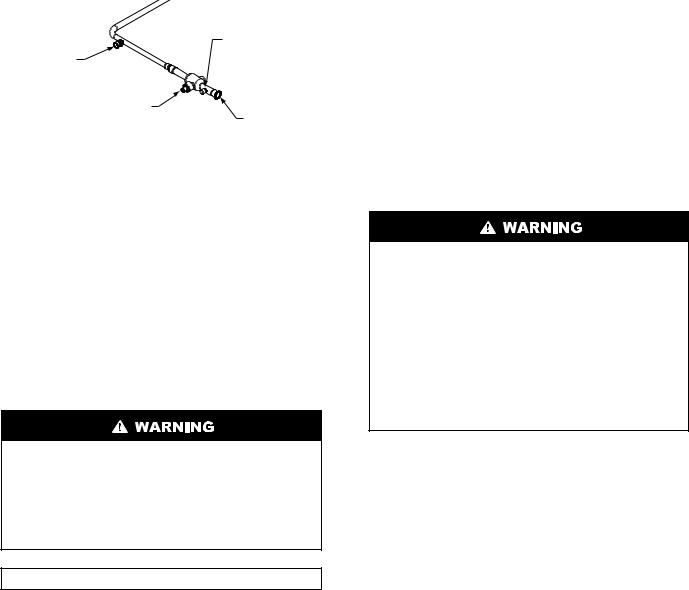
MAKE PIPING CONNECTIONS — Piping connections at the 38AUQ unit are ball valves with stub tube extensions. Do not open the unit service valves until all interconnecting tube brazing as been completed.
The stub tube connections include ¼-in SAE service fittings with Schrader valve cores (see Fig. 7). Before making any brazed connections to the unit service valves, remove both Schrader valve caps and cores and save for re-installation. Connect a source for nitrogen to one of these service fittings during tube brazing to prevent the formation of copper oxides inside the tubes at brazed joints.
|
Field Service |
|
Factory |
Access Port |
|
(Schrader core) |
||
High-Flow |
||
|
||
Access Port |
|
|
Service Valve |
|
|
with Stem Cap |
Sweat |
|
|
Connection |
Fig. 7 — Typical Piping Connection Assembly
When connecting the field tubing to the 38AUQ service valves, wrap the valves in wet rags to prevent overheating
Pressure-test all joints from outdoor unit connections over to the indoor coil, using nitrogen as pressure and with soap-and- bubbles.
When pressure-testing is completed, remove the nitrogen source at the outdoor unit service valves and re-install the two Schrader valve cores. Torque the cores to 2-3 in-lbs (23-34 N-cm).
Where vapor line is exposed to outdoor air, line must be insulated. See Table 7 for insulation requirements.
EVACUATION/DEHYDRATION — Evacuate and dehydrate the connected refrigeration system(s) (excluding the 38AUQ unit) to 500 microns using a two-stage vacuum pump attached to the service ports outside the 38AUQ service valves, following description in GTAC II, Module 4, System Dehydration.
UNIT OPERATION AND SAFETY HAZARD
Failure to follow this warning could cause personal injury, death and/or equipment damage.
Puron® (R-410A) refrigerant systems operate at higher pressures than standard R-22 systems. Do not use R-22 service equipment or components on Puron refrigerant equipment.
IMPORTANT: Charge in Cooling mode only!
PRELIMINARY CHARGE — Before starting the unit, charge R-410A liquid refrigerant into the high side of each 38AUQ circuit through the liquid service valve(s). The amount of refrigerant added must be at least 80% of the operating charge listed in Table 2 for LINEAR line length LESS the factory charge quantity (if factory shipping charge has not been removed). See the following example.
Allow high and low side pressures to equalize. If pressures do not equalize readily, charge R-410A vapor (using special service manifold with expansion device) into the suction line service port for the low side of system to assure charge in the evaporator. Refer to GTAC II, Module 5, Charging, Recover, Recycling, and Reclamation for liquid charging procedures.
Example:
38AUQ*08
60-ft (18.3 m) linear line length Equivalent line length 90-ft (27.4 m) Liquid Lift: 20-ft (6.1 m)
Select line sizes from Table 2 (38AUQ): Liquid 1/2 in
Suction 1-1/8 in.
Charge 23.0 lbs (at 75-ft linear length) 80% of Operating Charge:
0.80 x 23.0 = 17.6 lbs
Factory Shipping Charge: 12 lbs
Field-charge quantity: 17.6 lbs –12.0 lbs = 5.6 lbs
For linear line lengths longer than 100 ft (30.5 m), contact your local Carrier representative for system charge value.
Step 6 — Install Accessories
Accessories requiring modifications to unit wiring should be completed now. These accessories may include Winter Start controls, Low Ambient controls, phase monitor, Compressor LOCout. Refer to the instructions shipped with the accessory.
Step 7 — Complete Electrical Connections
ELECTRICAL SHOCK HAZARD
Failure to follow this warning could result in personal injury or death.
Do not use gas piping as an electrical ground. Unit cabinet must have an uninterrupted, unbroken electrical ground to minimize the possibility of personal injury if an electrical fault should occur. This ground may consist of electrical wire connected to unit ground lug in control compartment, or conduit approved for electrical ground when installed in accordance with NEC (National Electrical Code); ANSI/ NFPA 70, latest edition (in Canada, Canadian Electrical Code CSA [Canadian Standards Association] C22.1), and local electrical codes.
NOTE: Check all factory and field electrical connections for tightness. Field-supplied wiring shall conform with the limitations of 63°F (33°C) rise.
Field Power Supply —
If equipped with optional Powered Convenience Outlet: The power source leads to the convenience outlet's transformer primary are not factory connected. Installer must connect these leads according to required operation of the convenience outlet. If an always-energized convenience outlet operation is desired, connect the source leads to the line side of the unit-mounted disconnect. (Check with local codes to ensure this method is acceptable in your area.) If a de-energize via unit disconnect switch operation of the convenience outlet is desired, connect the source leads to the load side of the unit disconnect. On a unit without a unit-mounted disconnect, connect the source leads to compressor contactor C and indoor fan contactor IFC pressure lugs with unit field power leads.
All units except 208/230-v units are factory wired for the voltage shown on the nameplate. If the 208/230-v unit is to be connected to a 208-v power supply, the control transformer must be rewired by moving the black wire with the 1/4-in. female spade connector from the 230-v connection and moving it to the 208-v 1/4-in. male terminal on the primary side of the transformer. Refer to unit label diagram for additional information.
10
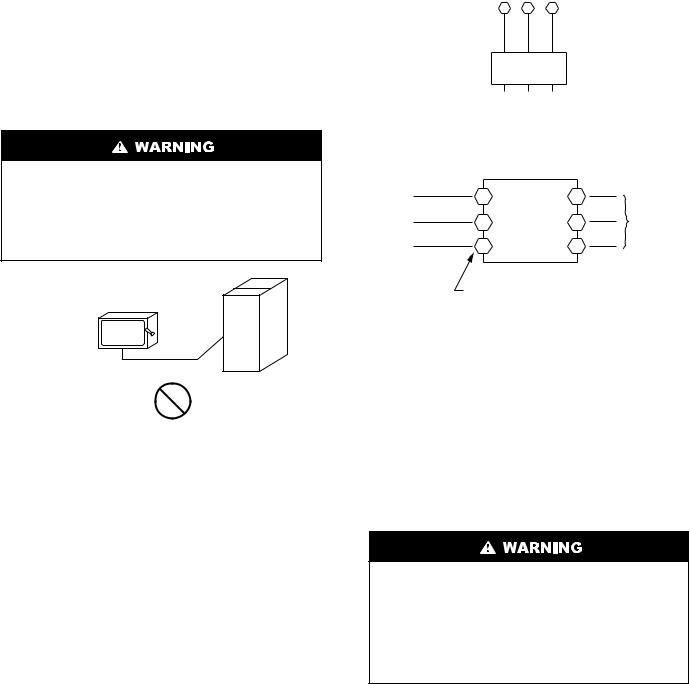
Field power wires are connected to the unit at line-side pressure lugs on compressor contactor C and TB1 (see wiring diagram label for control box component arrangement) or at facto- ry-installed option non-fused disconnect switch. Max wire size is #4 AWG (copper only).
NOTE: TEST LEADS - Unit may be equipped with short leads (pigtails) on the field line connection points on contactor C or optional disconnect switch. These leads are for factory run-test purposes only; remove and discard before connecting field power wires to unit connection points. Make field power connections directly to line connection pressure lugs only.
FIRE HAZARD
Failure to follow this warning could result in intermittent operation or performance satisfaction.
Do not connect aluminum wire between disconnect switch and condensing unit. Use only copper wire.
(See Fig. 8.)
ELECTRIC
DISCONNECT
SWITCH
COPPER
WIRE ONLY
ALUMINUM
WIRE
Fig. 8 — Disconnect Switch and Unit
Units Without Factory-Installed Disconnect —
When installing units, provide a disconnect switch per NEC (National Electrical Code) of adequate size. Disconnect sizing data is provided on the unit informative plate. Locate on unit cabinet or within sight of the unit per national or local codes. Do not cover unit informative plate if mounting the disconnect on the unit cabinet.
Units with Factory-Installed Disconnect —
The factory-installed option disconnect switch is located in a weatherproof enclosure located under the main control box. The manual switch handle is accessible through an opening in the access panel.
All units -
All field wiring must comply with NEC and all local codes. Size wire based on MCA (Minimum Circuit Amps) on the unit informative plate. See Fig. 9 for power wiring connections to the unit power terminal block and equipment ground. Maximum wire size is #4 ga AWG per pole.
Provide a ground-fault and short-circuit over-current protection device (fuse or breaker) per NEC Article 440 (or local codes). Refer to unit informative data plate for MOCP (Maximum Over-current Protection) device size.
Units Without Disconnect Option
C TB1
11 13
Disconnect per NEC
L1 L2 L3
208/230-3-60 460-3-60 575-3-60
Units With Disconnect Option
L1 |
2 |
|
1 |
|
|
|
|
Optional |
|
Factory |
|
L2 |
4 |
Disconnect |
3 |
||
Wiring |
|||||
|
|
Switch |
|
||
|
|
|
|
||
L3 |
6 |
|
5 |
|
Disconnect factory test leads; discard.
Fig. 9 — Power Wiring Connections
All field wiring must comply with the NEC and local requirements.
Voltage and Current Balance -
Voltage to compressor terminals during operation must be within voltage range indicated on unit nameplate. See Table 10. On 3-phase units, voltages between phases must be balanced within 2% and the current within 10%. Use the formula shown in the legend for Table 8, Note 5 (see page 14) to determine the percent of voltage imbalance. Operation on improper line voltage or excessive phase imbalance constitutes abuse and may cause damage to electrical components. Such operation would invalidate any applicable Carrier warranty.
Convenience Outlets
ELECTRICAL OPERATION HAZARD
Failure to follow this warning could result in personal injury or death.
Units with convenience outlet circuits may use multiple disconnects. Check convenience outlet for power status before opening unit for service. Locate its disconnect switch, if appropriate, and open it. Tag-out this switch, if necessary.
Two types of convenience outlets are offered on 38AUQ models: Non-powered and unit-powered. Both types provide a 125-volt GFCI (ground-fault circuit-interrupter) duplex receptacle rated at 15-A behind a hinged waterproof access cover, located on the end panel of the unit. See Fig. 10.
11
